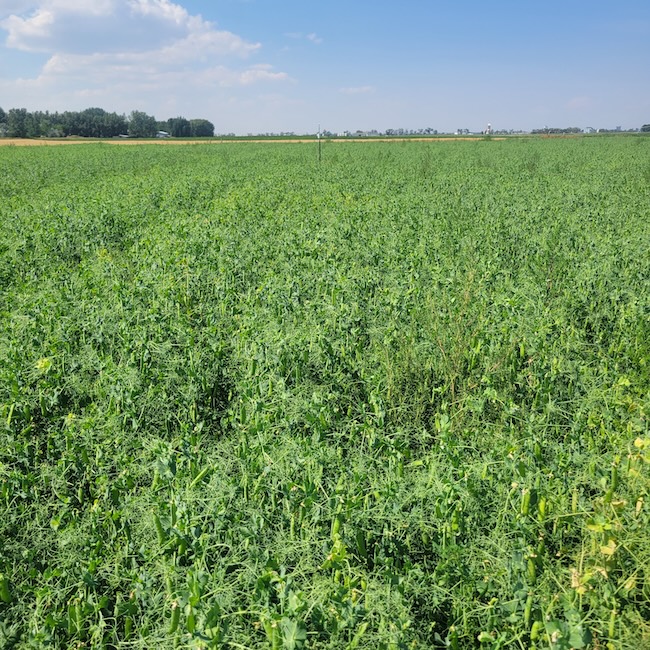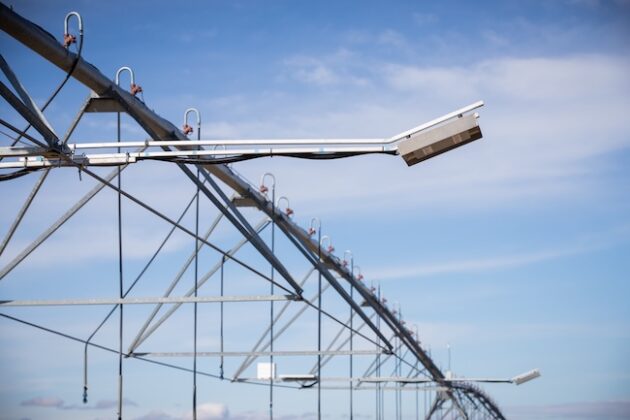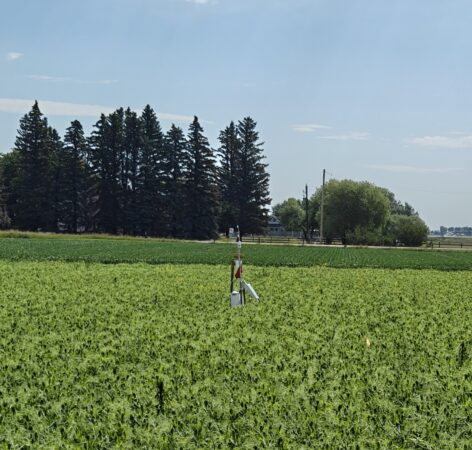
Features
Irrigation
Every drop counts
Researchers explore subsurface drip irrigation for broadacre crops.
September 11, 2025
By Joey Sabljic
 Subsurface drip irrigation system in field peas. Photo courtesy of Brady Sherwood, Lethbridge Polytechnic.
Subsurface drip irrigation system in field peas. Photo courtesy of Brady Sherwood, Lethbridge Polytechnic.
Water efficiency is a game of inches. Growers in irrigation districts are allotted a certain amount of water – usually around 18 inches – to get their crops through the season. However, in drought years, that allotment might be as low as eight or 10 inches, bringing even greater pressure to irrigate as efficiently as possible.
Researchers from Lethbridge Polytechnic – led by Willemijn Appels, Mueller applied research chair in irrigation science, are going in-depth on subsurface drip irrigation (SDI) systems to understand whether they can deliver greater water use efficiency over industry-standard pivot boom systems.
“The severe drought conditions we’ve seen over the past five to seven years really have people wondering what are the possibilities,” says Appels. “I think it’s timely that we look into these things now so we can ensure not only that we’re using water as efficiently as possible, but irrigated agriculture is sustainable well into the future.”
To stay above or go below
Appels points out that subsurface drip irrigation is not a new concept – being commonly used on smaller-acre specialty vegetable crops. However, SDI is a new idea for broadacre crops like wheat and canola.
The biggest hurdle, historically, has been the upfront work and cost involved in burying irrigation equipment beneath the soil surface, as opposed to building an overhead pivot. There’s also the fear that those buried irrigation lines might accidentally get hit during tillage. According to Appels, RTK guidance and minimum till systems all but eliminate the risk.
Why consider subsurface irrigation?
The question remains: Why would broadacre growers want to trade in their centre pivot for a subsurface system? After all, centre pivot is an industry-standard, proven technology.
The biggest issue, says Appels, is that pivots don’t allow growers to fully fine-tune water delivery to plants. “If you think of getting to the ‘next level’ of reducing water losses from the irrigation system, there’s not so much left to do,” she explains. “You can fine-tune some nozzles, but if you have high wind and sunshine, any water that gets trapped in the crop canopy will evaporate and not reach the ground.”

Researchers are looking at the use of microwave radiometry technology. Photos courtesy of Rob Olson and Brady Sherwood, Lethbridge Polytechnic.
The working assumption is that centre pivot systems are about 85 per cent efficient at reaching the soil. While this may seem reasonable, that extra 15 per cent does matter. “If you’re in an especially dry and warm season where you don’t get much rain, that extra 15 percent is like gold,” says Appels. “So, then you start thinking not only about how to use your water best, but where to apply it.”
In a centre pivot system, growers should ensure water is applied into the crop canopy and on the soil surface. It then eventually moves into the soil and slowly makes its way down to the root system. With SDI, water is injected almost directly into the root system 10 to 12 inches beneath the soil surface, and evaporation and potential runoff are minimized.
Appels and her team suspect that this would boost the plants’ ability to survive heavy drought conditions and find whatever moisture might be buried deep. “Where you put your water, and how you do that during crop establishment determines later in the season how the plant will be able to tap into moisture,” says Appels.
The researchers will be exploring how much crop they were able to produce per drop of pivot and SDI-irrigated water. They’re also measuring evapotranspiration, or the amount of water that turns into vapour from the plant and soil surfaces.
Managing the potential pitfalls
One thing to keep in mind when looking at SDI is the direction that water travels. Normally, a grower would try to germinate a crop with small applications, such as a quarter inch on the soil surface every three or four days. In an SDI system, however, you’re trying to make water travel upwards to the soil surface – and adding a quarter inch won’t cut it.
Because most of the action is taking place underground, it can also be difficult for growers to see an immediate, obvious impact after irrigation. “If you can’t see what you’re doing, you can mismanage water. If you put in too much water in one go or over time, and your soil was quite wet to begin with, you run the risk of creating a downward pipeline, and leaching,” Appels explains.
Implementing SDI
A potential benefit for subsurface irrigation comes down to geography – or, rather, the shape of land. “There have always been oddly shaped parcels of land where the circular pivot just doesn’t hit and can’t irrigate,” she says. “So, our thinking is that those areas could be a much better fit for SDI, if growers wanted to try out the technology on limited acres.”
Appels also observes that SDI systems – like centre pivots – allow canals to be transformed into water pipelines that help trap and recirculate water, as well as prevent leaching, seepage and evaporation.
She sees opportunities for SDI to be implemented as growers continue to expand and convert their dryland acres to irrigation. “There is plenty of water to go around at this point – but not everywhere and not all of the time,” says Appels. “I think a lot of our work with SDI is about being prepared for when we might see bigger water restrictions in the future and need to be as targeted and efficient as possible.”
Microwave radiometry technology creates “water maps” of soil
Alongside their water efficiency work, Appels and her team are also looking at the use of microwave radiometry technology to create “water maps” of soil. The idea is to take much of the guesswork out of irrigation and show growers where the biggest pockets of available moisture are throughout their fields.
“We want to know in detail how much water is available to the plant and how much water that plant is using throughout different growth stages,” says Appels. “So, we’re always looking for the best tools to help us do that.” She adds that microwaves are thought to penetrate deeper into the soil profile and provide data that is more related to soil moisture, compared to other remote sensing bandwidths.
Typical moisture sensors, on the other hand, can’t be easily moved around and they only provide one data point, when soil moisture can be highly variable from one part of the field to the next.
With microwave radiometry technology, a sensor would be mounted directly on a centre pivot boom to scan the field to create a moisture map. This, says Appels, could allow growers to implement variable-rate irrigation so that they’re not over-applying in areas with plenty of available water.
